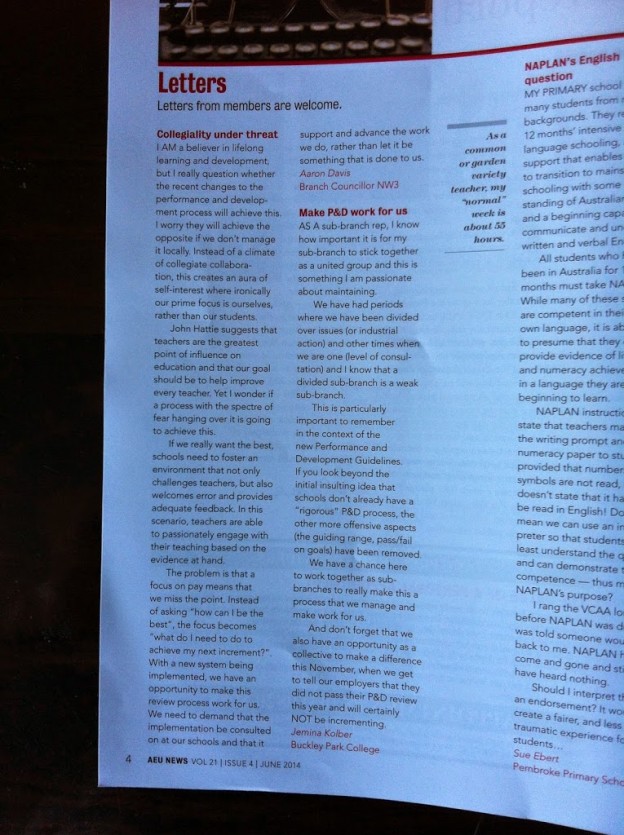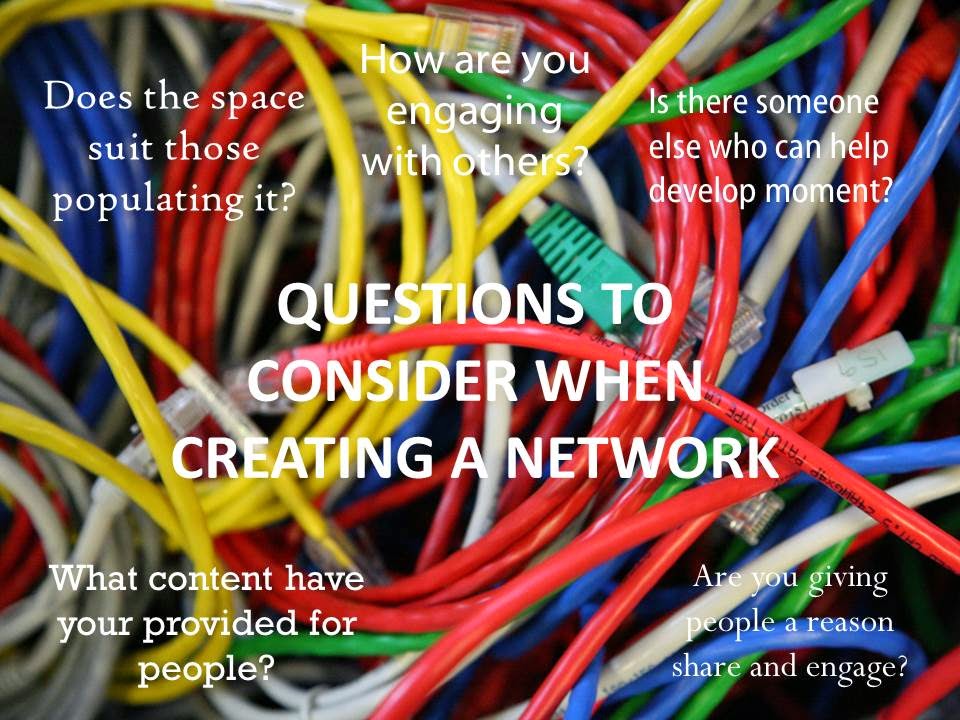
Via @hhoede on Twitter
I remember late last year discussing ICT with a guy I know who loves technology and he suggested to me that you need a complete vision for technology in school. Don’t say, ‘I wan’t iPad’s in Early Years or laptops in Secondary’, you need to have in mind a complete vision as to what a 21st century classroom looks like, for students, for teachers, for parents, for administration, for everyone.
I understood what he was saying, that when it comes to 21st century learning, it is important to have a narrative, a story to tell, a painting to show in order to provide the reason and purpose behind the call for change. The problem is that a part of me felt that every time I started imagining such a reality it simply collapsed in heap. All I could see were the road blocks, the hurdles to be jumped. For as I spoke about in my post on
excuses, we so often worry about what is not possible and start there. Instead, I have decided that I am going to lay down my dreams, create a vision of my future and start there. So here is my dream for technology in education, actually for education in general …
An Appropriately Funded Education System
Graham Brown-Martin recently
posted a graphic comparing military and educational spending around the world. Although there are some countries which spend more on education, such as Norway, Mexico and Canada, more often than not there is often an unequal divide. However, even this only tells part of the story. For what inadequate funding is provided is then often inequitably shared out. There simply needs to be more public money spent on education for it is an investment that all of society benefits from. The Gonski-cum-Better Schools plan was a step towards a more equal divide in Australia, but even that was undermined as it was in stark contrast to the recommendations that the panel headed by
David Gonski put forward. The reality is, it does not matter how much technology you have in the classroom, if you don’t have the appropriate structures in place to support it, then it is often meaningless. Funding is a big part of education.
No More Technological Hurdles or Hindrances
I want a learning environment where connection to projectors, to the Internet or school networks is seamless. No more disconnect, connect or finding a cable for the screen. Although many schools have moved to devices such as Apple TV, I feel that the better answer needs to be more open. In addition to this, I want devices which don’t take forever to load up or need to be managed in regards to battery time. Technology should not hold us up, instead it should allow for the more effective use of learning time.
1:1 Powerful Devices
Fine many schools are moving towards BYOD, however I think that as a part of a properly funded education system, all students should be provided with a powerful device to aid their learning (powerful is in reference to a point made in a discussion as a part of
Episode 185 of the
+Ed Tech Crew Podcast.) I just don’t think that it is either equitable or necessarily fair to have a situation where there are some students in the classroom that due to a range of circumstances are unable to bring a device or have one provided by the school. I am fine if students bring in a second device, such as a tablet. However, making sure that all students have access at the point of instruction is a necessity.
Teachers Given Access to Multiple Devices
I love my laptop, but feel that in a classroom it has its limits. I love my iPad, but feel that when it comes to more series work that it has its limits. I believe that every teacher should have access and be supported with two working devices.
+Rich Lambert wrote a fantastic post exploring the issue of
whether teachers should have to pay for the technology they use. He suggested that devices should be subsidised and a wider choice provided. Having been provided with a iPad due to my role in the school, I find it frustrating that this access is often limited to those who choose to bring their own. I would go a step further than what Richard is suggesting and argue that all teachers such be provided with two devices to support their teaching, a point I have also made
elsewhere.
Access and Infrastructure
Associated with the need for funding for teachers devices is the need for acceptable access and infrastructure. There are too many tales of public schools going out and purchasing their own lines, because the Internet and access supplied by the government is either unreliable and inadequate. In addition to the pipe coming in, there needs to be appropriate support and investment in regards to the infrastructure within the school. The worst scenario in regards to technology is having a classroom full of devices which are limited to themselves or a digital camera with no computer cable or battery charger. No point owning a fast car if there are no roads to drive it on.
Curating not Consuming
Too often the focus of ideas and information seems to be around consumption. Take for example English, there is still the focus in too many classrooms on how many books have been read, rather than what is actually done with that reading.
+Heather Bailie makes the suggestion, in her post ‘Curation as a Tool for Teaching and Learning’, that we should no longer read, write and react, but rather create, curate and contemplate. In this situation, students (and teachers) would not just collect information, but “comprehend, critique, think critically and use digital media strategically.” To me, the biggest change in the 21st century is that whereas in the past information was often considered in isolation, as we move towards a focus on curation, everything becomes interconnected and ideas move between subjects, across years, between classrooms and across borders.
Teachers a Part of a Community
A big part of curating is sharing information. A sad irony in today’s world of growing connectedness is that you still hear stories of teachers keeping their thoughts and ideas to themselves, instead of actually giving back to the wider community. Now when I say ‘sharing’, I’m not talking about sharing to make teaching easier, rather I believe that sharing makes learning richer.
+Dean Shareski even goes to the point of saying that without sharing, there is no learning.” For me, being a connected educator has not only had a positive influence on me as a learner, but also my work teacher. A part of this is change has been
openly reflecting on my practise online. The big challenge is to make this deep and meaningful for everyone, not simply dry and tokenistic, something ticked off on a sheet, but something intrinsic to who we are, something that we want to do, rather something that we are forced to do. In this environment, teachers are then instilled with more ownership over their learning. Rather than buying goods from a small corner store, where what is available is often curtailed by what the owner has bought, teachers can have the choice and variety available at a shopping centre, where they can mix and match, coming up with their own
cocktail.
Students Publishing for an Authentic Audience
I am always left wondering when teachers run around after student work, ringing home to complain, chastising students for falling behind, who is this all for? Here I am reminded of Alan November’s
story about the student who spent hours writing stories for
Fan Fiction, yet failed to get her homework done. The explanation that the student provided was that she makes the choice to publish for the world over publishing for her teacher. Instead of completing tasks for themselves or worse, for teachers, students need the opportunities to publish for authentic audiences. For example, after consulting with a teacher from another state
+Cameron Paterson got his Year 9 History class to
create picture books around the topic of World War 1 for a kindergarten. If not publishing for a purpose, at least publishing for a wider audience as
+Bec Spink has done with the
eBooks created by her Prep classes or through a classroom blog as
+Celia Coffa has
discussed. For what is the point of having a fast car if there is nowhere to actually drive it?
Collaboration not Competition
A part of the problem that I find with a lot of assessment is that too often it is done in isolation, where everyone maybe responding to the same question, they do so individually. There is so much discussion in education about feedback, in particular peer-to-peer feedback, I have concern though that when this is done in an environment where the focus is being the best and therefore being better than everyone else, we miss out on an important aspect of learning, that is collaboration, connections and global communication. Technology provides so many means for this to occur, whether it be working on a project using a Google Doc or connecting all over the world using Twitter.
+Anne Mirtschin provides endless examples in her
blog as to how technology can be used to open up learning to the world. Whether it be learning how to use Scratch or having a guest author Skype in, Mirtschin always has a story as to how technology opens doors in her classroom to deeper learning. Just as it is said that if a question can be Googled then it isn’t a very good question, I would like to pose that if a task is corrupted by being done in collaboration with others then maybe it isn’t a very good task?
Students Learning at the Centre
Although students are often the focus of learning, I wonder if they are necessarily at the centre of it? There are too many choices about the what and why of learning that are made for students.
+Ewan McIntosh makes the point that the challenge of finding a problem, one of the most important aspects of learning, is often the first decision taken away from students. Ideally, learning should be at the centre. In his excellent series on learning theories,
+Steve Wheeler spoke about
heutagogy, the study of self-determined learning. Ultimately, as we aspire to develop lifelong learning, actually learning how to learn in different contexts for different purposes is most important. For as Wheeler suggests
elsewhere, “pedagogy is leading people to a place where they can learn for themselves.” Sometimes though it feels like students are learning for us?
Learning Supported by Space
I must admit, the structure of space is something that I haven’t necessarily thought a lot about and probably should. I think that one of the reasons for this is that so often it feels like such decisions are made for us, not by us and certainly not by students. I remember reading a
post by
+Matt Esterman on what your schools would say if they could talk. Along with
+Stephen Collis‘ response, I was quite challenged. At the very least I think that we need to create flexible learning spaces. This maybe team teaching and open learning spaces, but it also maybe having different uses of the spaces we already have, as was outlined by
+Michelle Hostrup on
Episode #20 of
+TER Podcast. The reality is that although we can make some changes to what we have now, many schools need to be refurbished to account for this change. At the very least, as
+George Couros pointed out, technology should not be an event, done in a lab, rather it should be a part of all learning, whatever space that maybe.
Integrated Assessment & Reporting
At present, teachers often give feedback along the way and some sort of detailed assessment at the end. Using technology this can not only become more streamlined, but also more effective. What’s more, it means that the conversation is not always one way. For if a student wants clarification then they can follow up whenever they like. This will hopefully blend with a more fluent reporting system which continually grows and develops to show a students progress over time, rather than the current culture where students get a report at the end of each semester, which other than the previous progression points, exists as an isolated historical snapshot. As
+Catherine Gatt so succinctly
put it, “assessment is just charting the next part of a student’s journey, invariably owned by them and not by me.” Technology only aides and increases this dialogue that is too often missing in education.
…
I feel in many respects that this vision could be more cavalier, could be more bold. However, I am sure that the more I grow and evolve, so to will my dreams and ideals about education. This then is my starting point. It may not be a vision for tomorrow, but it is a vision for a better future. The challenge is to stop making excuses. Although
ideals aren’t always ideal, working towards them is the least I can do.
If you have any thoughts, ideas or suggestions, I would love to hear them. Even better, what are your dreams for technology in education or education in general? For if there is one thing that I have learnt, we are all better off together.
If you enjoy what you read here, feel free to sign up for my monthly newsletter to catch up on all things learning, edtech and storytelling.



















